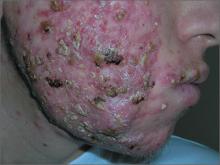Based on the patient’s severe cystic acne with sinus tracts between the cysts, the FP diagnosed acne conglobata in this patient. Acne conglobata is an uncommon and unusually severe form of acne characterized by multiple comedones, cysts, sinus tracts, and abscesses. The inflammatory lesions and scars can lead to significant disfigurement. Sinus tracts can form with multiple openings that drain foul-smelling purulent material.
The FP recognized that this patient needed oral isotretinoin (which he didn’t prescribe), so he referred the adolescent to a local skin specialist. Isotretinoin (once known by the discontinued brand name Accutane) is the most powerful treatment for all forms of severe acne. It is especially useful for cystic and scarring acne that has not responded to other therapies, and is dosed at approximately 1 mg/kg per day for 5 to 6 months. Women of childbearing age must use 2 forms of contraception or strict abstinence, as it is a potent teratogen. Isotretinoin should be avoided in patients with a strong history of depression.
The US Food and Drug Administration requires that individuals prescribing, dispensing, or taking isotretinoin register with the iPLEDGE system (www.ipledgeprogram.com). Since the start of this program, the percentage of FPs prescribing isotretinoin has significantly decreased. However, FPs with an interest in dermatology are not prohibited from prescribing it.
Prior to the patient’s specialty appointment, the FP started the patient on oral doxycycline 100 mg BID. When the FP with special training in dermatology saw the patient, he initially prescribed oral prednisone 40 mg/d and changed the antibiotic to trimethoprim/sulfamethoxazole (which is more potent and reserved for severe forms of acne). Within 2 weeks, the acne was improving and the patient was willing to start school.
Oral isotretinoin was initiated after one month while continuing the prednisone for another month. The prednisone served as a potent anti-inflammatory agent and was needed to prevent worsening of the acne at the time of isotretinoin initiation. The acne conglobata cleared with minimal scarring after 5 to 6 months of isotretinoin therapy.
Photos and text for Photo Rounds Friday courtesy of Richard P. Usatine, MD. This case was adapted from: Usatine R. Acne vulgaris. In: Usatine R, Smith M, Mayeaux EJ, et al, eds. Color Atlas of Family Medicine. 2nd ed. New York, NY: McGraw-Hill; 2013:651-658.
To learn more about the Color Atlas of Family Medicine, see: www.amazon.com/Color-Family-Medicine-Richard-Usatine/dp/0071769641/
You can now get the second edition of the Color Atlas of Family Medicine as an app by clicking on this link: usatinemedia.com


